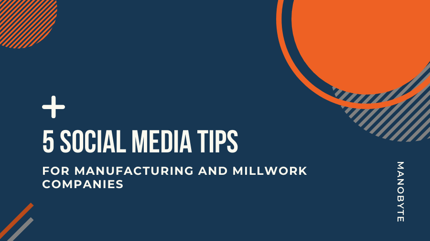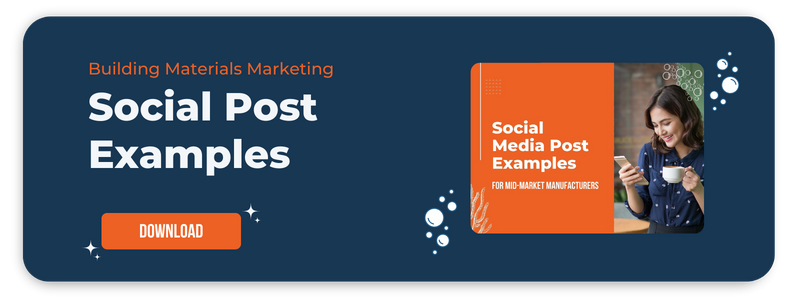
Social media manufacturing content is on the rise and B2B companies are working to take full advantage of the benefits that come with these outreach platforms. Here are our top social media manufacturing and millwork tips for 2021.
1. Focus on Retaining Loyal Customers
Don’t look at social media just as a place to increase new leads. Yes, you can certainly reach out to new people on social media, but your social accounts should be first and foremost directed towards your loyal customers. It’s cheaper to keep around good customers then keep trying to expand by cultivating new leads.
You can use your social media presence as a place where current customers can follow up on orders, get help, learn about new products, keep up with any company changes, and even leave invaluable reviews.
2. Don't Overstretch Your Presence
You may feel pressure to be on all platforms, but unable to really keep up with them. From LinkedIn to Twitter and YouTube, there are a lot of places where B2B companies can reach their prospects and customers in different ways. However, if you don’t keep up with the platforms you start up, you will look sloppy or inactive. Only pick up the social media accounts you have time to utilize regularly.
- Facebook has the largest number of users, so you can reach a bigger audience. You will be able to effectively target users here and even set up a ChatBot for Messenger to help field leads and answer basic questions fast (and cheap!).
- Instagram is a highly influential platform that is growing in popularity with the manufacturing industry because of its simple layout, clean profile layouts, and easy posting.
- LinkedIn has over 722 million users and more than half of B2B buyers (52%) have reported LinkedIn as the top channel that impacted their research process, followed by blogs (42%).
- YouTube offers a place to host dynamic video content that can also be beneficial embedded in blogs on your site. Companies can stand out with videos that answer questions and showcase products.
- Twitter is fast and easy, reaching over 330 million monthly active users. You can include links and content without being restricted from your followers' feeds (like you are on Facebook until you sponsor ads).
These are all really good platforms you should be taking advantage of, but only if you can truly keep up with the different demands and purposes of each platform—and not just cross-post. Most companies end up outsourcing marketing and social media (or at least part of it) in order to successfully juggle the complexities of a strong digital marketing strategy.
3. Share Useful Content
Maybe this seems obvious, but most companies get caught in a deep desire to share their brand-centric content. It can be hard to see how content seemingly unrelated to your products or company will indirectly build a connection that turns into a buyer. But, if your content becomes solely about your products and company, then buyers simply won’t pay attention. People don’t mind being sold to when they are looking to buy, but when they are just browsing or looking for answers to a specific question, they will turn to the companies that offer value.
If you fail to share useful content that isn’t centered around your brand, you will miss out on those buyers that are in the early stages of their buyer journey—you will only successfully target the buyers who are committed to a purchase and doing the research to compare brands. That makes you late to the game.
Write valuable social media posts or point to an in-depth blog post for effective inbound marketing. You can cover topics like:
- Budgeting and planning: Solve production, worker, or machine issues.
- Troubleshooting tips: For your own products or for common industry tools/processes.
- Expert perspective: Share your insights as a manufacturer.
- Comparative articles: Leasing vs buying, machine A vs machine B, 2020 vs 2019 perspectives, etc.
- FAQs: Not about your company, but those questions you field frequently about the industry, machines, processes, or requirements.
- Industry updates: Social media is the perfect place to post quick updates that alter how your customers do business and you can help keep them informed!
4. Build a Strategy Backed By Analytics
Don’t just wing social media. There is too much value here to throw your content on the wall and see if it sticks. Build a strong social media manufacturing strategy and back it up with the key performance indicators that will help you determine success rates. Vanity metrics, like followers or likes, won’t tell you much about true impact, so choose your analytics carefully.
You should know if you are succeeding or failing with your approach to social media. You could be wasting time and opportunity if you are flying blind on your posting.
5. Learn About Your Audience
Social media is a great place to learn about your B2B manufacturing and millwork buyers. You will gain all kinds of valuable insights with interactions held on social media, including the kind of content they respond to. You can use social listening tools to find out what your audience is saying about your company, products, or industry to better inform your steps going forward.
Ready to Dive In?
Work with our team of Business Process experts and watch us take manual clunky systems, tech stacks, and processes and turn them into tailored, intelligent workflows that deliver business outcomes.


